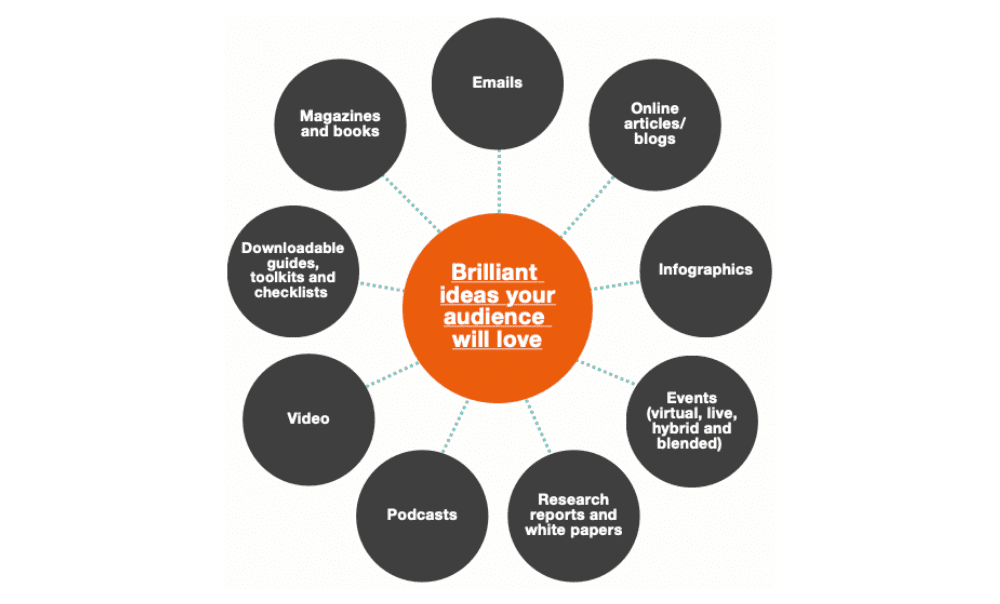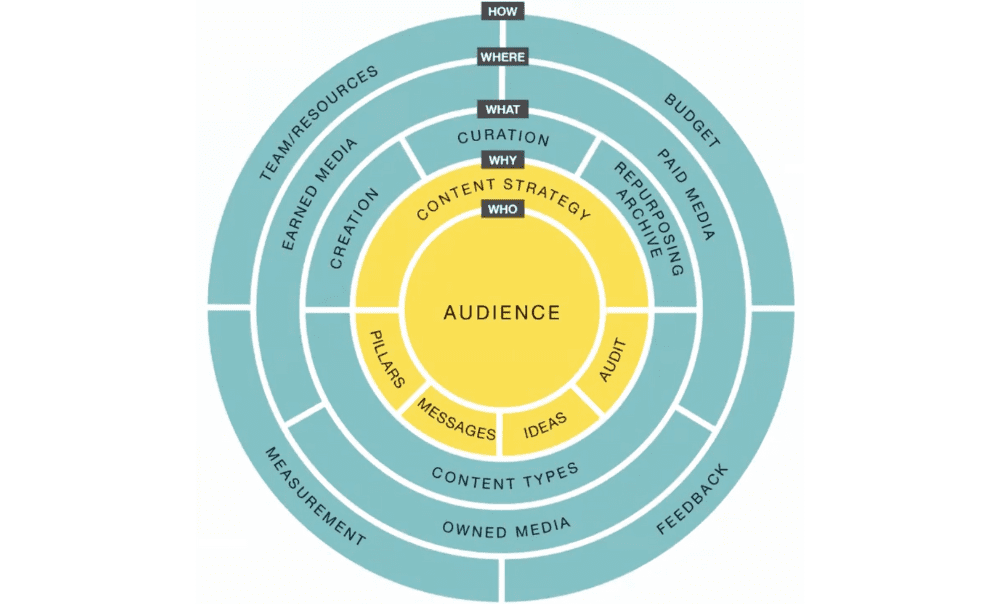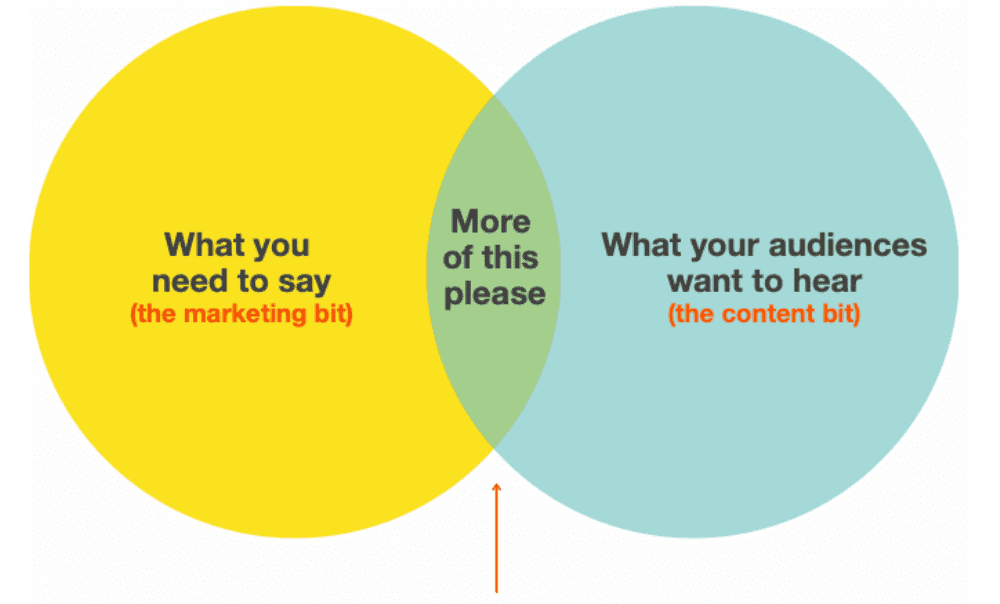According to the Content Marketing Institute, 60% of organisations with a documented strategy consider themselves to be effective – but only 9% of consumer organisations and 3% of professional organisations surveyed in our Re:member research feel “very confident” that their content strategy is meeting their membership needs. We think it’s time to change that.
Following Think’s content strategy masterclass, Executive Director, Jackie Scully, offers her step-by-step guide on developing your organisation’s content strategy – cutting through the noise and creating content that means something to both your audience and to your business.
Step one: Understanding content strategy
While creating your organisation’s content strategy might seem like an overwhelming and complicated task, Jackie simplifies a content strategy as simply being the process of taking your business purpose and using it to give your communications purpose. Basically, it’s all about creating the right content, at the right time, in the right place, for the right people – and for all the right reasons. Once you’ve nailed this, you’ll boost your brand, your business, and your bottom line. Sounds great, doesn’t it?
However, Jackie is quick to point out that what content strategy ISN’T about is death by document. To create meaningful content with a purpose, you don’t need to create a massive tome that gathers dust in someone’s inbox. Your content strategy should be a living document that the people within your organisation can review, update and adapt as your organisation develops.
Step two: Define your ‘why’
Before you can even begin defining your content strategy, Jackie stresses the importance of defining your business ‘why’. Why does your organisation exist?
A brand’s content strategy can only be defined once the organisation and its key stakeholders can define three key things:
- Where the business is going
- What the business needs to be delivering to achieve its objectives
- Why the business even exists – and where else audiences would go if not to them.
Once these key questions have been answered, only then can the organisation’s content purpose and objectives be defined.
Step three: Rethink your content calendar
Often, membership organisations – and brands in general – start the year with an annual content marketing plan of what they’d like their communications to look like. This usually includes things like a weekly email, a quarterly magazine, and daily website and social media updates.
As a result, communication programmes are built around hitting quotas and ticking boxes, rather than what it is your business is actually trying to say – and what it can say better than anyone else.
Instead, Jackie recommends this approach:

A content strategy is essentially those brilliant ideas in the middle, shaped around your business first and the medium in which the content is going to be distributed second, whether that’s via newsletters, articles, videos or a podcast.
You don’t need to focus on the form of content first. Instead, think about the truly important things that you and your organisation have to say this year, and what matters to your members or audience.
Step four: Understand who it is you’re talking to
Now you know your organisation’s purpose, it’s time to drill down into further detail.
Many organisations have their five-year vision and business plan mapped out. They then have a defined channel mix to communicate with their audiences. But, what they’re often missing is their audience and content strategy objectives – essentially the bit that sits between the vision and the ‘stuff’ that ensures you are putting your attention in the right place.
In order to help organisations shift their focus, Jackie has created the Wheel of Engagement:

The secret for success is to start by zoning in on your business’s ‘who’, rather than the outside rung of ‘how’ (which is where most organisations often tend to start). Who are the people that you need to talk to so you can deliver on those business objectives? What is it that you need to be telling each of them? And critically, where is your target audience currently looking if they’re not looking at you?
It’s a good idea here to make a note of your main competitors and what they’re saying. Are they saying it better than you? If they are, maybe that topic doesn’t need to be part of your content strategy, and perhaps you could just curate similar information rather than creating it. It’s good to remember that you can’t be all things to all people, so instead just focus on what your organisation is good at.
Step five: Work out why your audience should listen
This step comes back to identifying what it is that your business can say far better than anyone else – this is what will make your audience sit up and listen. Think about the resources that you have available as a business.
Find out what it is that your audiences like by looking at high-performing content you’ve already created for inspiration. Then, find your sweet spot to grow your audience and attention – here’s where you’ll find it:

You don’t want to lean too heavily into the blue ‘content bit’, nor do you want to push marketing messages at your audiences too heavily by just updating them with things your business needs to say or by asking them to do things.
Instead, the sweet spot is where you go to deliver successful content marketing. This is content that’s valuable, high-quality, instructive, and insightful – but it’s backed up by the things you need to achieve as a business, too.
To help you reach this sweet spot, first define your content mission statement:
[INSERT YOUR BRAND NAME] is [EXPLAIN YOUR POSITION IN YOUR SPECIALIST SPACE], delivering [OUTLINE WHAT YOU CAN SAY BETTER THAN ANYONE ELSE] so that [CELEBRATE YOUR IMPACT].
Remind yourself of your business goals, your content product, your audience, and your users’ needs. Write these down and then try to knit them together – can you write them as a strapline, a hashtag, or even a manifesto? Play around with this as an organisation and see where you land to help you define your bespoke content strategy.
Finally, put some meat on the bones of your strategy by building out your editorial pillars and principles. Come up with between three and five words or phrases that help you go into more detail about what it is you want to be talking about. For example, do you want to talk more about your impact and influence? If so, then ‘impact’ should be one of your pillars to focus your content teams.
Don’t forget to define your brand’s voice, too. Deciding on how you want to sound in every piece of content helps to form part of your content personality – if you can get this right, you can share it with everyone within the business that’s representing you, and then have a cohesive and consistent tone when communicating with your audience.
Step six: Find your big ideas
Bring together key stakeholders within your business to work out what content your organisation should be covering over the next year. Think about the themes and ideas that matter to you as an organisation so you can create an ongoing, steady drumbeat of content throughout the year.
One of the key things to remember here, however, is that nothing is original – don’t be afraid to look back and recycle your brilliance. You don’t need to reinvent the wheel every time, and not every piece of single content you create must be a stand-out piece of Hero content.
Instead, balance your content calendar with a steady mix of Hero, Help, and Hub content. Put simply, Hero is the big stuff; your ‘award-winning’ content that requires maximum effort and is often audience or member related. It’s often where you want to be an agent of change – you see a problem and you want to offer a solution, and this is what your Hero content might talk about. Aim for a few Hero pillars throughout the year, bearing in mind that these pieces can be quite labour-intensive.
Support these big pieces with smaller Help and Hub pieces. Help content is your practical, useful, thought-leadership material that encourages people to learn more, whereas your Hub content is specifically the more evergreen stuff. What can you do, recycle, and republish every year? Understanding this will save you a lot of time when planning your annual content production.
Step seven: Decide what goes where
Next, we move onto the ‘what’ stage. Here, it’s important to remember that less is more – no-one really has the time to read all your content, so stop creating more of it, and start reusing what you’ve already got.
For example, what can you signpost to instead? And what have you done before that you can repurpose? Can you stitch together existing content into a downloadable guide? Can you reutilise content and put it out to different people for different purposes? What works well will often work well again.
Next, think about your content types. Try and think beyond simple written text to look at video, audio, and even animated infographics. Storytelling doesn’t just start and end with brilliant words.
Once you’ve agreed on your content types, you need to find a good home for your content. Be mindful of ‘locking down’ your content too much – having some behind a paywall or membership sign-up can be really beneficial, but you’ll need to ensure visitors to your content have an initial good experience so that they keep coming back. Part of that is ensuring there’s enough content in the first place.
Being discoverable is also highly important – great content is only great if people can find it! Your owned content is brilliant, but don’t spend so much time here that you forget about amplification. Spend time thinking how you’re getting that content out there and focusing on your ‘earned’ content. This can be great for Hero content – maybe people are shouting about it and sharing it because it’s so great. Earning ambassadors and PR is great for amplification, so ensure you pay proper attention to your paid and earned spaces, as well as your own.
Step eight: Determine how you’re going to do it
Although this is our final step, this is probably the one that most organisations are in danger of starting with when it comes to planning their annual content production. However, this part can only come after you’ve worked out what it is you need to achieve as an organisation.
Once you’ve identified the things you need to do to communicate with your audiences, compare this with team resources and the budget that’s available – chances are, you’ll have to prioritise and eliminate the less important things, so the two can match up. Don’t always focus on the people creating content in your business, though; involve departments from across the business to talk about their ideas, thoughts, challenges, and experiences. Draw on anything you can to hit your sweet spot and find out the stories that you should be telling. Then you can do the really fun bit – bring your strategy to life.
As well as throwing a party to celebrate, Jackie recommends turning all the bits discussed here into a ‘content playbook’. This is a designed-up guide encapsulating your organisation’s decisions regarding your strategy. Done well, this will transform your ideas and thoughts into a living document that people within your business will use and remember (you could even create posters too). The playbook ensures people listen to your strategy and utilise it in their day-to-day work. Make sure everyone knows and understands the direction of your strategy – this is what will make your content amazing.
The last thing to consider as part of this work is measurement. In short, you need to measure what matters, looking at how your business is doing as a result of your strategy. How is what you’re creating impacting what’s going on in the business? Don’t chase vanity metrics, when organisational performance is all that really matters (the FD will thank you for it, too).
Now is the time to go forth and strategise – but remember to make it fun, make it collaborative and, most importantly, make it happen.





